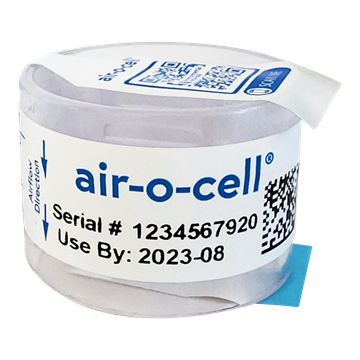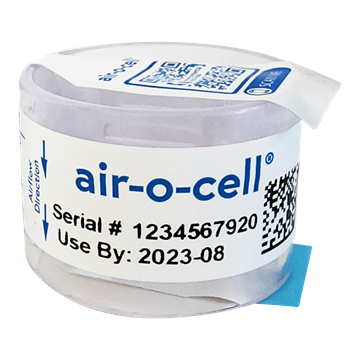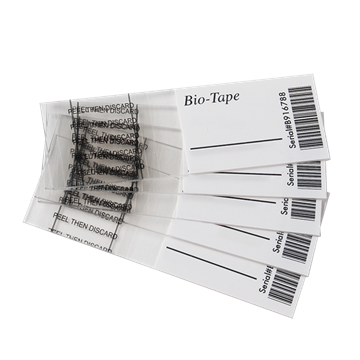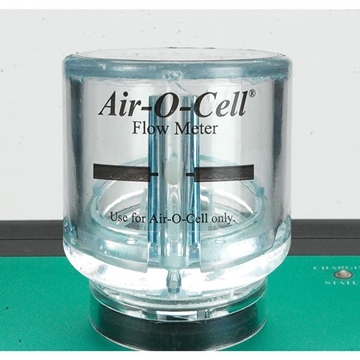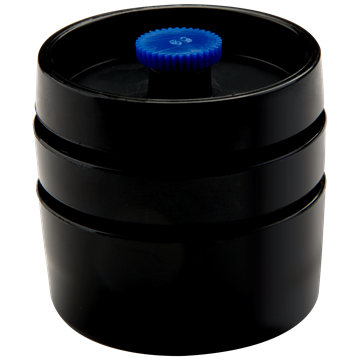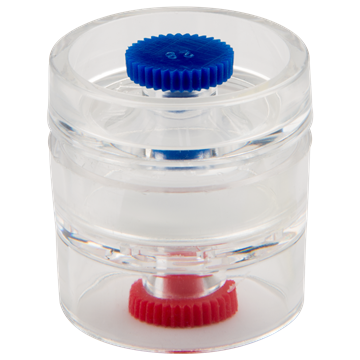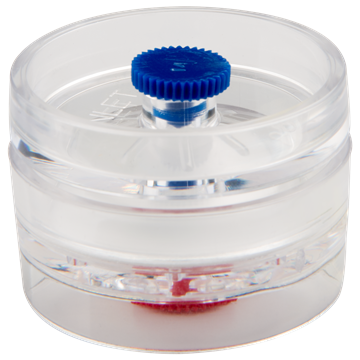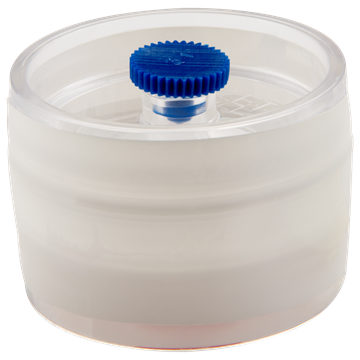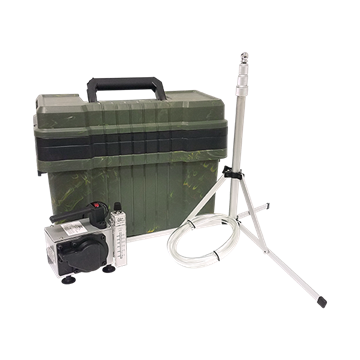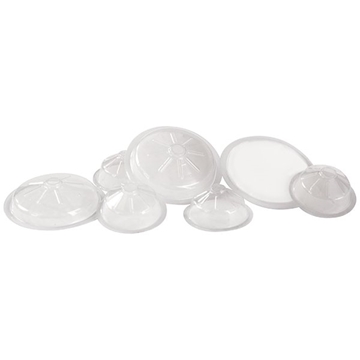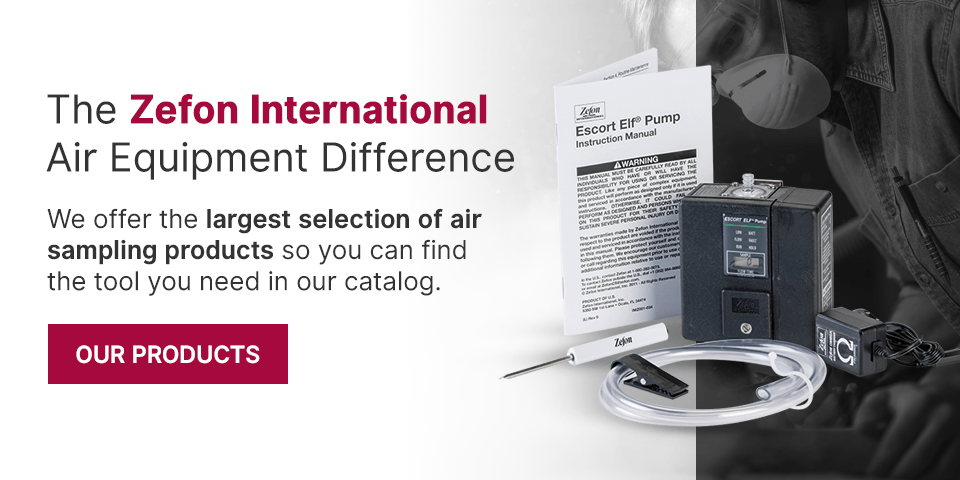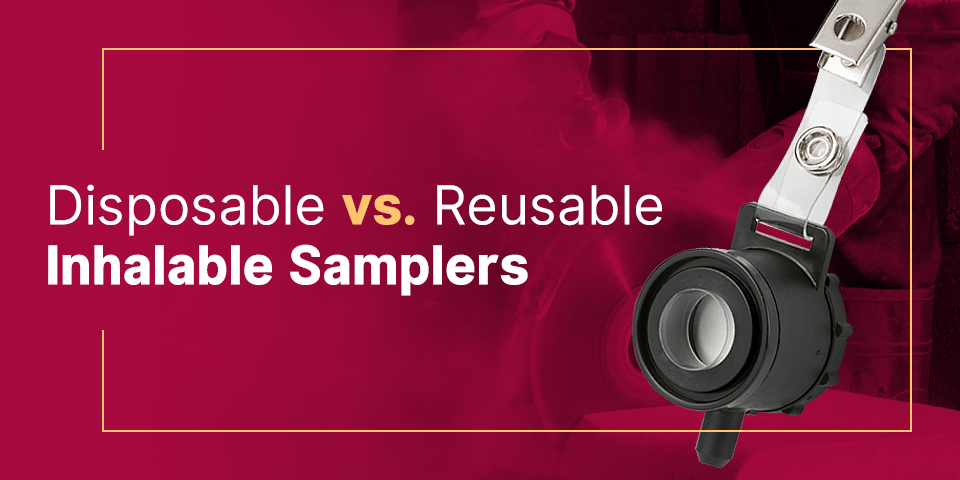
Table of Contents
- What Is an Inhalable Air Sampler?
- Components and Application of Inhalable Air Samplers
- Contaminants Inhalable Air Samplers Can Detect
- Types of Inhalable Air Samplers
- Pros: Why Buy a Disposable Inhalable Air Sampler
- Cons: Why You Might Not Buy a Disposable Inhalable Air Sampler
- Pros: Why Buy a Reusable Inhalable Air Sampler
- Cons: Why You Might Not Buy a Reusable Inhalable Air Sampler
Despite what the adage claims, what people can't see can harm them. Outdoor and indoor air can be full of dust particles, gases or vapors can contribute to issues such as lung disease. When a person inhales something that is potentially harmful to their health, the process is known as inhalation exposure.
Inhalation exposure can lead to chronic and potentially life-threatening illnesses. In the U.S., at least 15 percent of new asthma cases diagnosed in adults are the result of occupational exposure to inhaled particles and substances. Exposure to dust such as coal dust, asbestos, and silica dust on the job can lead to a condition known as pneumoconiosis. Symptoms of pneumoconiosis include shortness of breath, coughing, and low blood oxygen levels.
Occupational lung diseases can develop as a result of repeated, long-term exposure or following a single exposure to a high volume of a particular agent. Avoiding the particulates that contribute to lung diseases can prevent them from developing in the first place. Minimizing exposure can also help to reduce the risk of illness and reverse conditions such as asthma.
Testing the air in a work setting or other environment allows a worker to know types of particulate that are in the air. Disposable and reusable inhalable air samplers provide a way to test the air.
What Is an Inhalable Air Sampler?
An inhalable air sampler is a filter that is attached to a sampling head. The goal of an inhalable air sampler is to measure the dust, aerosols, and particulates a worker might be exposed to while on the job. The Institute of Occupational Medicine (IOM), located in Scotland, developed a sampling head in the 1980s. The sampling head was designed to collect in the inhalable particle fraction or the mass fraction of total airborne particles which is inhaled through the nose or mouth. The inhalable air samplers developed and sold by Zefon International are based on the same design and replicate the features and collection efficiency of the samplers created by the IOM. Zefon air samplers are meant to be interchangeable with IOM samplers.
Inhalable air samplers are worn by the people using them. The sampling head clips to the front of a person's shirt, in the "breathing zone."
The inhalable sampler is attached to a personal pump by a length of flexible hose. Before the air sampler can be used, it needs to be calibrated, so that it takes in the appropriate volume of air per minute.
IOM inhalable air samplers have a recommended flow rate of two liters per minute (2 L/min) when used for personal sampling.
Components and Application of Inhalable Air Samplers
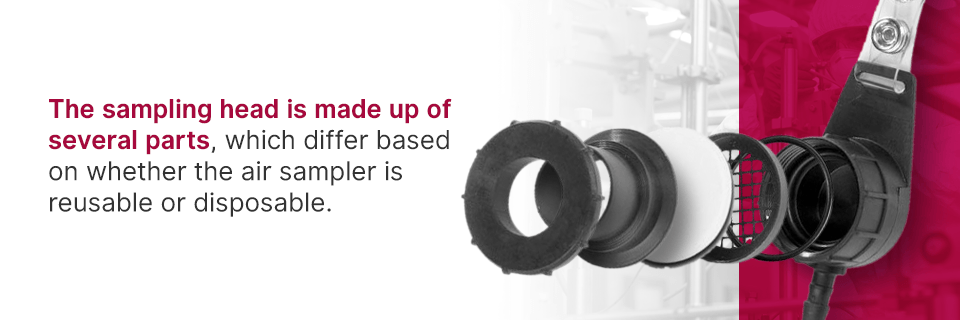
The inhalable sampler is made up of several parts, which differ based on whether the air sampler is reusable or disposable. Three components all inhalable air samplers have in common is the sampling head, cassette (top and bottom) and filter. The cassette contains a filter and is inserted to the sampling head.. A cap is put into place over the cassette inlet to keep unwanted debris from entering the cassette and getting onto the filter while in transport. The inhalable sampler also includes O-rings to make it leak-free.
Disposable inhalable air samplers include a pre-assembled cassette that has the filter sealed to it. The cassette, or now the filter capsule, rests on top of a cellulose pad. Both the pad and the filter capsule fit securely inside of the sampling head, which connects to the flexible tubing or hose.
An O-ring rests on top of the filter capsule, then the inlet is pressed and snapped in place. When the sampler is in storage or not in use, an inlet cap should be placed on the inlet to keep dust and particulates from getting into the filter.
The components found in reusable inhalable air samplers are slightly different, as the samplers are designed to be cleaned and used over and over again. Instead of a pre-assembled cassette or filter capsule, the sampling head is inserted with a cassette that is assembled just before sampling.
The cassette is made of two parts — the bottom, also known as the support grid, and the top, sometimes called the cassette front. When assembled, a filter is sandwiched between the bottom section and the top section of the cassette.
In some instances, the cassette might be preloaded brought to the site of testing in a transport clip. The clip slides on and off of the cassette and is meant to identify the cassette when it is sent to the laboratory for testing. The cassette will also most likely have a rubber cap that attaches to the front. The cap seals off the cartridge, keeping air away from the filter when it is not actively sampling.
Although the components found in disposable and reusable inhalable air samplers are slightly different, the method of using them and the process of calibrating them is the same.
To calibrate an inhalable air sampler, you use a calibration adapter. To set up the device, you place the air sampler into the adapter, securing it in place with the thumbscrew. Next, you connect an outlet port on the sampler to the corresponding fitting on the pump, using some flexible tubing. Another length of tubing is connected to the barb on the adapter and the corresponding outlet on the calibrator.
To start the process of calibrating, turn on the pump. Adjust the air flow of the pump until you get the desired reading on the calibrator. Usually, the desired flow rate is 2 L/min when using an inhalable air sampler.
The various applications for an inhalable air sampler include:
- ISO/CEN for bioaerosols
- NIOSH Method 5700 for particulate formaldehyde
- British Method MDHS 14/4 for sampling and gravimetric analysis of respirable, inhalable and thoracic aerosols
- British Method MDHS 14/3 for inhalable dust
- British Method MDHS 25/3 for organic isocyanates
- British Method MDHS 6/3 for lead
- ACGIH definition of inhalable particulate matter
- Australian standard for inhalable particulate
Contaminants Inhalable Air Samplers Can Detect
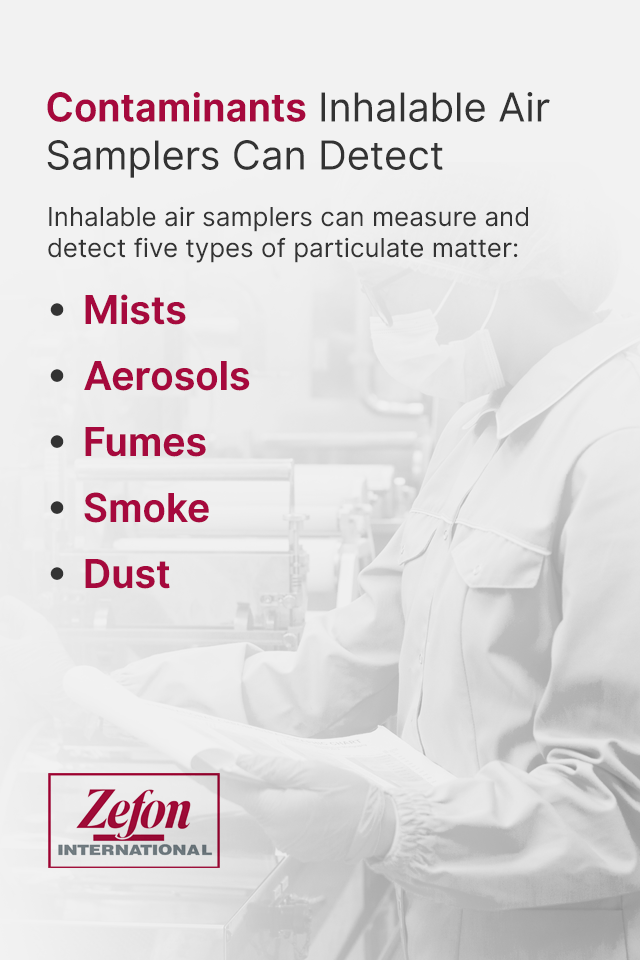
Air can contain one or more of three different types of contaminant. Those contaminants are:
- Vapors
- Gases
- Particulates
Vapors are gases that are condensable, meaning they are usually liquids or solids at room temperature and under normal pressure. When they are heated or when the pressure around them changes, they turn into gas. Gases don't condensate, meaning they remain in their gaseous form at room temperature. In the air, vapors that can be a cause for concern include volatile organic compounds (VOCs), mercury and some pesticides.
Although there are other methods of detecting vapor or gas contamination, inhalable air samplers exclusively measure the third type of contaminant, particulates. Particulates are tiny solid or liquid matter suspended in the air. Some particulates are big enough to see while others are so small they can only be viewed under an electron microscope.
The Environmental Protection Agency divides particulate matter (PM) into two categories based on size — PM10 and PM2.5. PM10 particles usually have a diameter under 10 micrometers (1 micrometer is 1/1000 of a millimeter). PM2.5 particles have a diameter under 2.5 micrometers.
Particulate matter not only differs when it comes to size. There are also considerable differences in the source of the material and how it is composed. What all types of particulate matter have in common is that exposure to the particles can cause significant health issues.
Inhalable air samplers can measure and detect five types of particulate matter:
- Mists: Mists are typically a collection of liquid droplets in the air. Usually, mist is visible to the human eye.
- Aerosols: Aerosols are tiny solid or liquid particles suspended in a gas.
- Fumes: When a solid material is heated until it turns into a gas, then cooled again, it can produce fumes.
- Smoke: Smoke particles develop when something does not thoroughly burn or combust. Usually, smoke is made of carbon particles.
- Dust: Dust is made up of small particles that are suspended in the air temporarily. Dust comes from a variety of sources, including dirt, wood and human skin. Sanding wood, tracking dirt in from outdoors or exfoliating the skin are all factors that can contribute to dust.
Types of Inhalable Air Samplers
The two main types of inhalable air samplers are disposable air samplers and reusable air samplers. With a reusable sampler, you can reuse the cassette repeatedly. Between uses, it's essential to clean the components of the air sampler so to avoid cross-contamination.
There are two ways to clean a reusable air sampler. After taking the sampler apart, you can clean the pieces with a solvent such as rubbing alcohol, then dry it with a lint-free cloth. The second option is to take apart the sampler and place the components in an ultrasonic cleaning device that uses soap and water.
With a disposable air sampler, each cassette is designed for one-time use, eliminating the need for cleaning.
Should you use a disposable or a reusable inhalable air sampler? Each option has its benefits as well as drawbacks. Whether the benefits of a disposable inhalable sampler outweigh the benefits of a reusable inhalable sampler comes down to your preferences and opinion.
Pros: Why Buy a Disposable Inhalable Air Sampler
Compared to a reloadable sampler, a disposable model offers a few benefits.
One primary benefit of a disposable inhalable air sampler is that the cassettes are pre-loaded. Not only does that save you time, as you don't have to put the pieces together yourself, it can also reduce the chance for error or contamination. When you assemble a cassette, it's essential that you do so in a clean environment while wearing gloves. If you neglect to put on a pair of clean gloves or if the area you are working in isn't entirely clean, contaminants can get on the filter or cassette, interfering with the effectiveness of the sampler. Reversely, the user reduces the chance of contamination after sampling is complete. These is no disassembly of the sampler. Simply put the inlet cap back into the transport position.
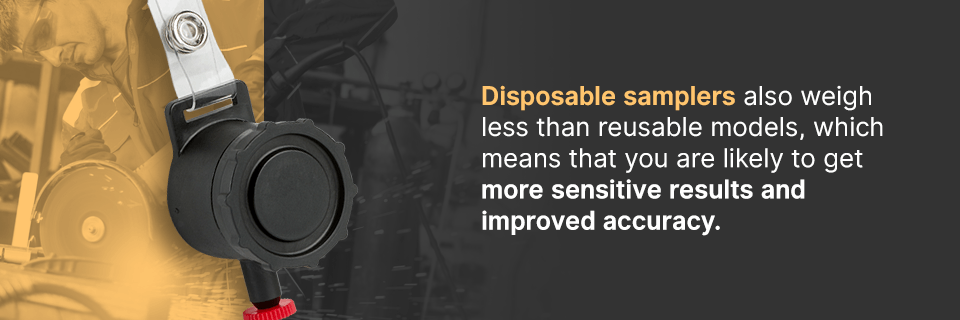
Disposable samplers also weigh less than reusable models, which means that you are likely to get more sensitive results and improved accuracy.
For metals testing, the entire filter capsule can be digested. This accounts for wall deposits and gives accurate exposure readings. The reusable sampler requires wiping the interior walls of the cassette to get an accurate result.
Cons: Why You Might Not Buy a Disposable Inhalable Air Sampler
If you are taking thousands of samples per year and have the expertise of proper handling and controls, a reusable sampler could be a better option.
Pros: Why Buy a Reusable Inhalable Air Sampler
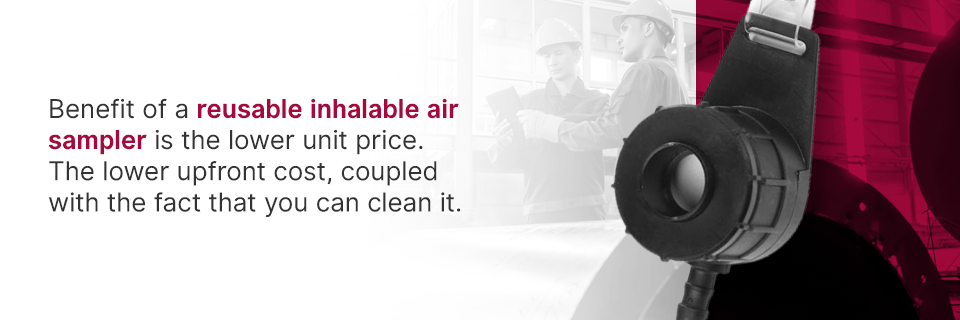
Perhaps the most significant benefit of a reusable inhalable air sampler is that you can reuse it. Depending on your sampling needs, being able to reuse the sampler itself can save time and money, as you can pre-assemble cassettes and swap them out as needed after testing the air. If you are going to reuse the sampler body with multiple cassettes, it is important to remember to wear clean gloves when handling the cassettes and to don a new pair of gloves before handling each one.
Cons: Why You Might Not Buy a Reusable Inhalable Air Sampler
One drawback of using reusable air samplers is that they do require a bit more care and attention compared to their disposable counterparts. For example, the cassettes that you use with a reusable sampler typically come with a transport clip. It's essential that you not lose the clip. Otherwise, there won't be a way for you to send the cassette to the lab for testing.
If the clip has a barcode on it, it's vital that you match up the correct cassette with the right clip when shipping your cassettes off for testing. If the clips get mixed up, the results you get might be inaccurate.
Since you need to assemble the cassettes yourself, there's a slight chance that a mistake will occur and the wrong cassette front will be matched to the wrong filter or back. While you can avoid assembly mistakes by exercising caution, there is still the risk of error, which is eliminated with the pre-assembled cassettes that come with a disposable sampler.
There is also the cost and care involved in cleaning. A technician that does not use proper care and technique while decontaminating can leave particulate in the cassette. This will give inaccurate exposure levels during analysis. There is expense involved with proper cleaning.
Why Buy Zefon Inhalable Air Samplers
Zefon International offers both disposable and reusable inhalable air samplers. Our samplers are replicas of the ones developed by the Institute of Occupational Medicine in Scotland. Our reusable air samplers are interchangeable with the ones produced by IOM while our disposable models are developed with similar criteria. The critical difference is that our disposable samplers aren't designed for reuse.
We stand behind our inhalable air samplers and promise that they will be free of defects and ready to provide you with accurate samples anytime you need them.
The Zefon International Air Equipment Difference
Whether you are in the market for a reusable air sampler, a disposable air sampler or are considering both, Zefon International aims to meet your need. We pride ourselves on being different from the rest and on making sure our customers have the best possible experience, both when interacting with us and when using our products.
We offer the largest selection of air sampling products so you can find the tool you need in our catalog. We also aim to offer our products at the best possible price to our customers, which means you not only get an air sampler you can depend on, you get one at a price that works with your budget.
Finally, we put customer service first. Should you have a question about a product or need assistance choosing the right air sampling equipment, we're here to help.
Browse our product catalog and discover the Zefon International Air Equipment difference for yourself today.
























